Venturing into the world of digital art is an exciting endeavor, but choosing the right tools can feel overwhelming. With countless options available, how do you know which software aligns with your skills, budget, and creative goals? Whether you're a complete novice aiming to sketch your first character or an aspiring illustrator looking for professional-grade features without a steep learning curve, the software you choose is your most important companion. This guide is designed to cut through the noise and provide clear, actionable advice.
We have meticulously reviewed and compared the best digital art software for beginners, focusing on what truly matters: intuitive interfaces, accessible pricing, unique features, and practical use cases. This resource is built to help you make an informed decision without wading through technical jargon. You will find in-depth analysis of each platform, complete with screenshots and direct links, to give you a genuine feel for the user experience.
We'll explore a diverse range of tools, from industry-standard applications like Adobe Creative Cloud and Procreate to powerful free options such as Krita and GIMP. We even cover innovative AI-driven platforms that create stunning visuals from simple text prompts. Our goal is straightforward: to help you identify the ideal software for your specific needs. By the end of this guide, you will have a clear understanding of each tool's strengths and limitations, empowering you to select the perfect software to unlock your artistic potential and start creating with confidence.
1. ai-media-studio
Best For: All-in-one AI-powered image generation for users without design experience.
AI Media Studio distinguishes itself as the definitive starting point for anyone entering the world of AI-assisted art. Its core philosophy revolves around accessibility, removing the steep learning curves and complex commands often associated with digital art software. This makes it an exceptional choice for beginners who want to produce professional-grade visuals without needing any prior design skills. The platform's intuitive interface allows you to generate stunning images simply by typing a descriptive prompt or uploading a reference photo.
What truly sets AI Media Studio apart is its remarkable versatility combined with simplicity. With over 50 distinct art styles available, from photorealistic to anime and watercolor, the creative possibilities are vast. This makes it a powerful tool not just for aspiring artists, but also for marketers, bloggers, and small businesses needing unique visuals for their projects. The platform's performance is streamlined for efficiency, delivering high-quality results in seconds.
Key Strengths and Use Cases
AI Media Studio is engineered to be a practical, results-driven tool. Its feature set directly addresses the needs of modern content creation.
- Effortless Content Creation: Generate unique blog post headers, social media graphics, and marketing assets without hiring a designer. Simply describe the image you need, and the AI brings it to life.
- Diverse Artistic Exploration: Experiment with styles like cyberpunk, fantasy, or abstract art to develop a unique visual identity for your personal brand or project.
- Advanced Editing Suite: Paid tiers grant access to powerful tools like inpainting (editing specific parts of an image) and outpainting (extending an image's canvas), offering creative control that rivals more complex software.
- Team-Focused Workflow: For agencies and marketing teams, the platform offers collaboration workspaces and straightforward export options, making it easy to manage projects and share assets.
Plans and Accessibility
AI Media Studio uses a flexible, tiered pricing model designed for scalability. You can start with a free plan that includes three monthly generations, which is perfect for testing the platform's capabilities without any financial commitment or credit card requirement.
| Plan Tier | Key Features | Best For |
|---|---|---|
| Free Starter | 3 generations/month, watermarked images | Hobbyists and casual users |
| Paid Tiers | Commercial use rights, high-res output, unlimited generation options, advanced editing tools | Professionals, businesses, and teams |
This transparent structure ensures users only pay for the features they need, avoiding hidden fees. The platform’s strict privacy policy is another significant advantage, guaranteeing that your prompts and creations remain confidential. For those interested in a deeper comparison, you can explore their analysis of the best AI image generators.
Visit ai-media-studio.com
2. Adobe Creative Cloud
Adobe Creative Cloud is the definitive suite for creative professionals, and for beginners serious about a future in digital art, it offers an unparalleled ecosystem. While known for its steep learning curve, its flagship program, Adobe Photoshop, remains the industry standard for a reason. It's more than just a photo editor; it's a powerhouse for digital painting, concept art, and graphic design, making it some of the best digital art software for beginners who plan to go pro.
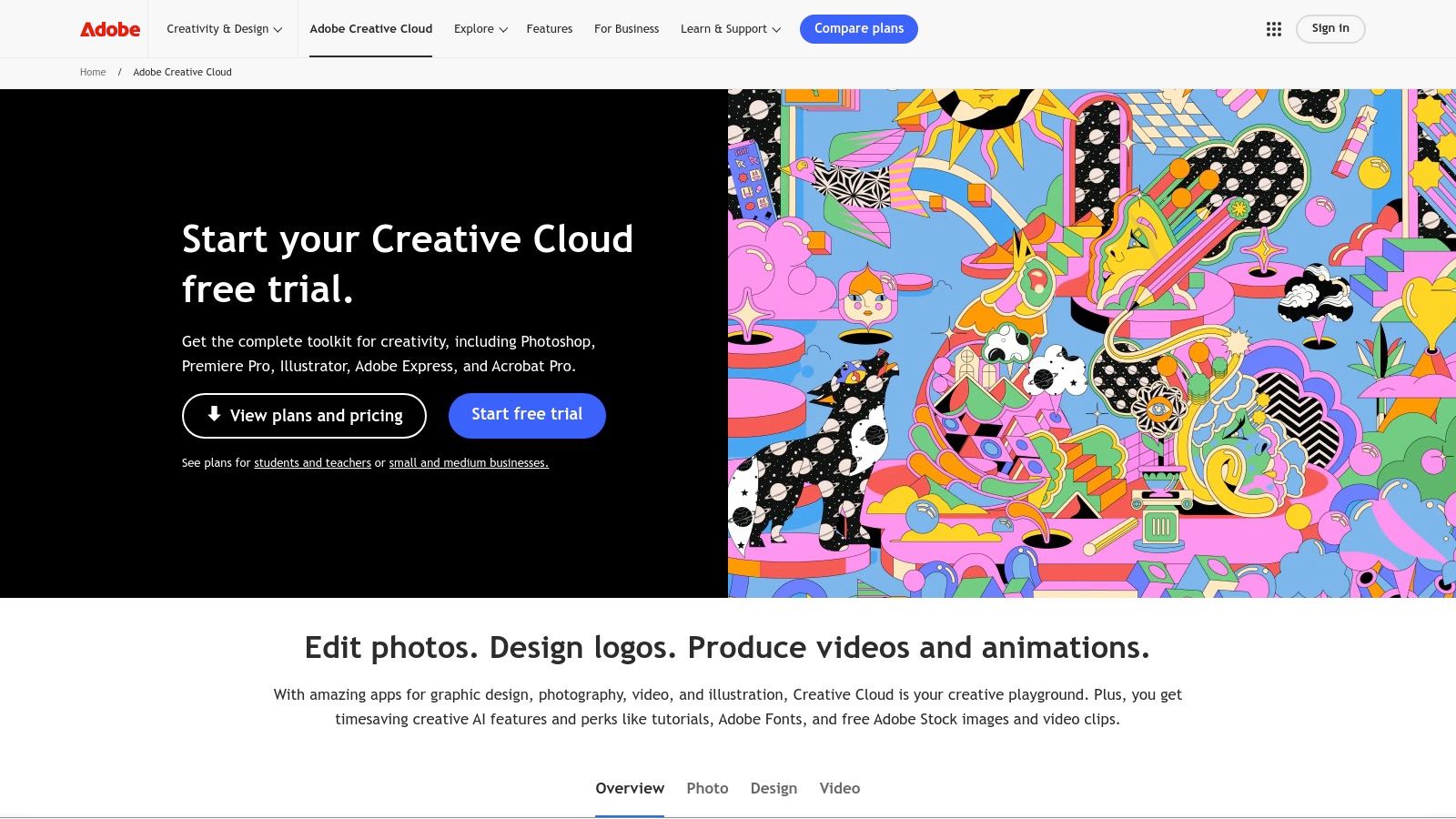
What truly sets Creative Cloud apart is its seamless integration. You can start a sketch in Photoshop on your iPad, refine it on your desktop, and then pull it into Adobe Illustrator to create vector line art without a hitch. The platform's vast library of high-quality brushes, textures, and fonts (Adobe Fonts) provides an incredible starting point.
Key Considerations
Access to the full suite requires a monthly or annual subscription, which can be a significant investment. The "Photography Plan" which includes Photoshop is a more affordable entry point. The user interface can be intimidating initially, but the sheer volume of high-quality tutorials available on Adobe's site and across the web is a massive advantage for dedicated learners.
- Best For: Aspiring professionals and students wanting to learn the industry-standard tools.
- Pricing: Subscription-based. The Photoshop-only plan starts at around $22.99/month, while the full Creative Cloud suite is more expensive.
- Limitation: The subscription cost and complex interface can be significant hurdles for casual hobbyists.
Website: https://www.adobe.com/creativecloud.html
3. Procreate
Procreate has become a dominant force in the mobile digital art space, offering an incredibly intuitive and powerful drawing experience exclusively for iPad. It's lauded for its natural feel, mimicking traditional art mediums with remarkable precision, thanks to its deep integration with the Apple Pencil. For many artists, from hobbyists to professionals, Procreate strikes the perfect balance between robust features and ease of use, making it some of the best digital art software for beginners who own an iPad.
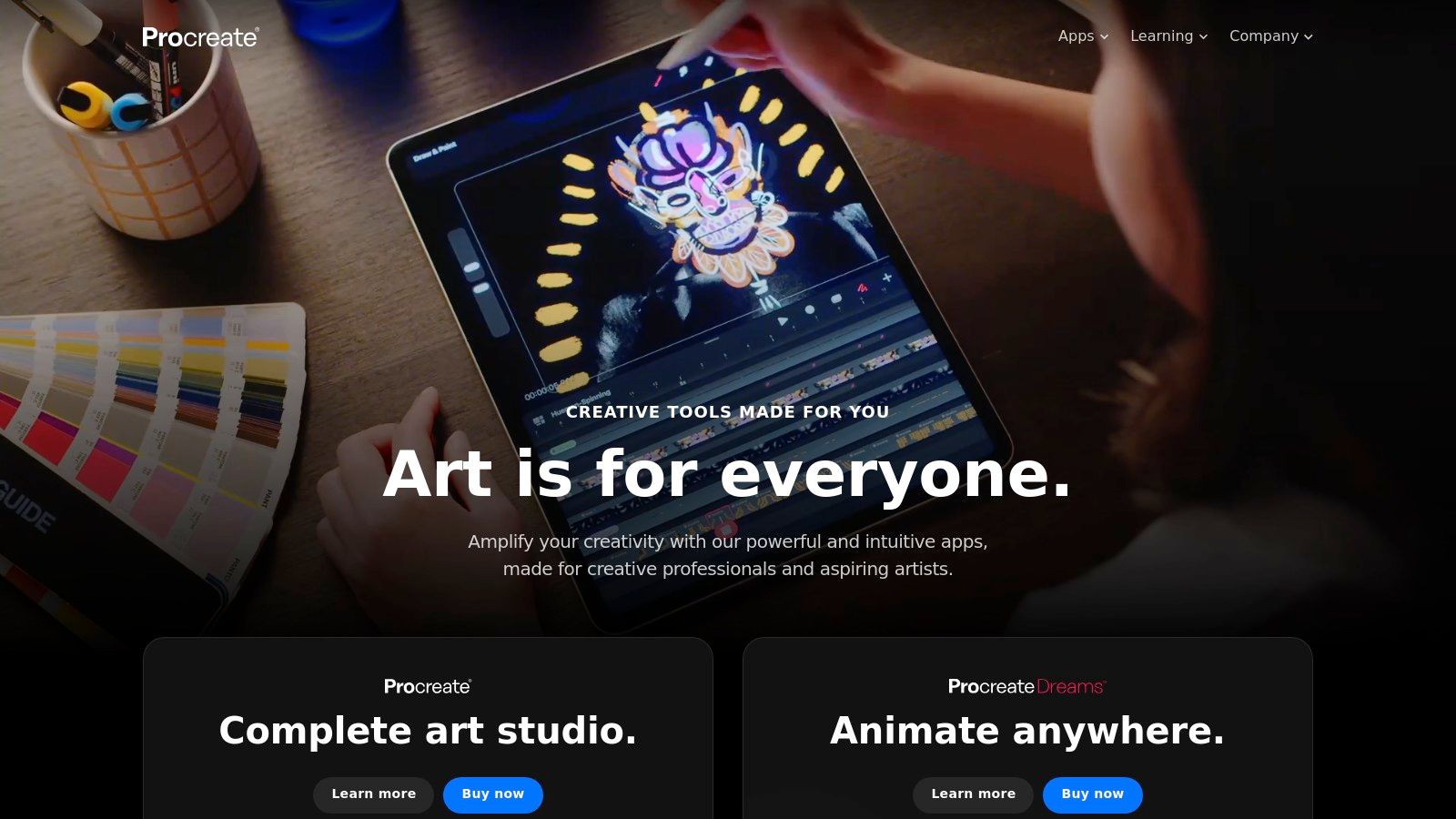
The app is celebrated for its clean, unobtrusive interface that puts the canvas front and center, allowing artists to focus on creating without being overwhelmed by menus. Its massive, highly customizable brush library and powerful brush engine let users create or import virtually any texture or tool they can imagine. Its performance is smooth and responsive, handling high-resolution canvases and multiple layers with ease, which is essential for detailed illustration work. The skill you build here is also directly applicable to other areas, which you can explore when learning about digital art commission prices.
Key Considerations
Procreate's greatest strength is also its main limitation: it is only available on Apple's iOS and iPadOS. This exclusivity ensures a highly optimized experience but leaves out Android and Windows users. While incredibly capable for illustration and painting, it lacks the advanced vector tools or photo manipulation features found in desktop software like Photoshop or Illustrator. However, its one-time purchase model is a massive draw for those wary of recurring subscriptions.
- Best For: iPad users of all skill levels, from beginners to professionals, focusing on illustration and digital painting.
- Pricing: A single, affordable one-time purchase of around $12.99 on the App Store, with free updates.
- Limitation: Exclusive to iPadOS and iOS, and lacks comprehensive vector or graphic design tools.
Website: https://procreate.com/
4. Affinity Designer
Affinity Designer has emerged as a powerful, budget-friendly champion, particularly for those interested in vector art. While Adobe Illustrator dominates the professional vector space, Affinity Designer provides a remarkably robust set of tools without the commitment of a monthly subscription. It uniquely combines vector and raster (pixel-based) workspaces, allowing you to create clean, scalable illustrations and then add detailed textures or shading without ever leaving the application. This makes it some of the best digital art software for beginners who want professional power and flexibility at an accessible price point.
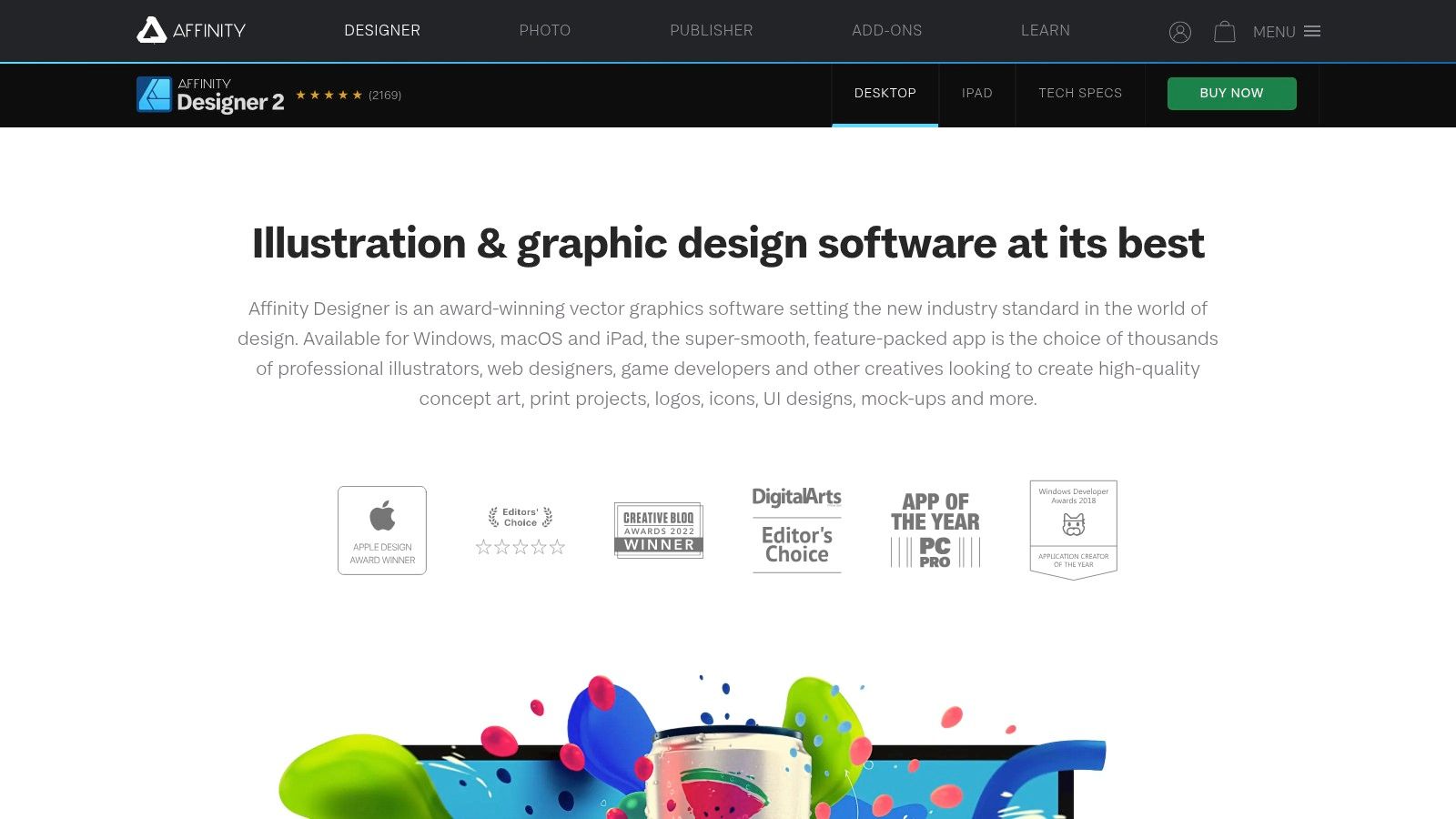
The platform is celebrated for its speed and efficiency, handling complex documents with thousands of objects without slowing down. Its one-time purchase model is a massive draw for beginners and hobbyists who are wary of recurring fees. The interface is clean and highly customizable, and while it might take some getting used to for absolute newcomers, its logical layout is less intimidating than many of its competitors. The full-featured iPad version is also a standout, offering a desktop-class experience on the go.
Key Considerations
The biggest advantage of Affinity Designer is its value proposition: a single, affordable payment gives you a lifetime license with free updates. This is a stark contrast to the subscription models that are now common. While there's a learning curve, especially if you're new to vector tools like the pen tool, the investment in learning pays off with a highly capable program. It handles standard file formats like AI, PSD, and PDF, ensuring good compatibility with other creative workflows.
- Best For: Illustrators, UI/UX designers, and artists who need a powerful vector editor without a subscription.
- Pricing: A one-time purchase of around $69.99 for desktop (Windows/macOS) and a separate purchase for the iPad version.
- Limitation: It lacks some of the advanced, niche features of Adobe Illustrator and has a smaller library of third-party plugins and tutorials.
Website: https://affinity.serif.com/designer/
5. Clip Studio Paint
Clip Studio Paint has carved out a dedicated following, especially among comic, manga, and illustration artists, for its specialized and powerful toolset. It brilliantly blends the natural feel of traditional drawing with the efficiency of digital creation. While it's a favorite of professionals, its intuitive design and one-time purchase option make it some of the best digital art software for beginners looking for a feature-rich alternative to subscription models.
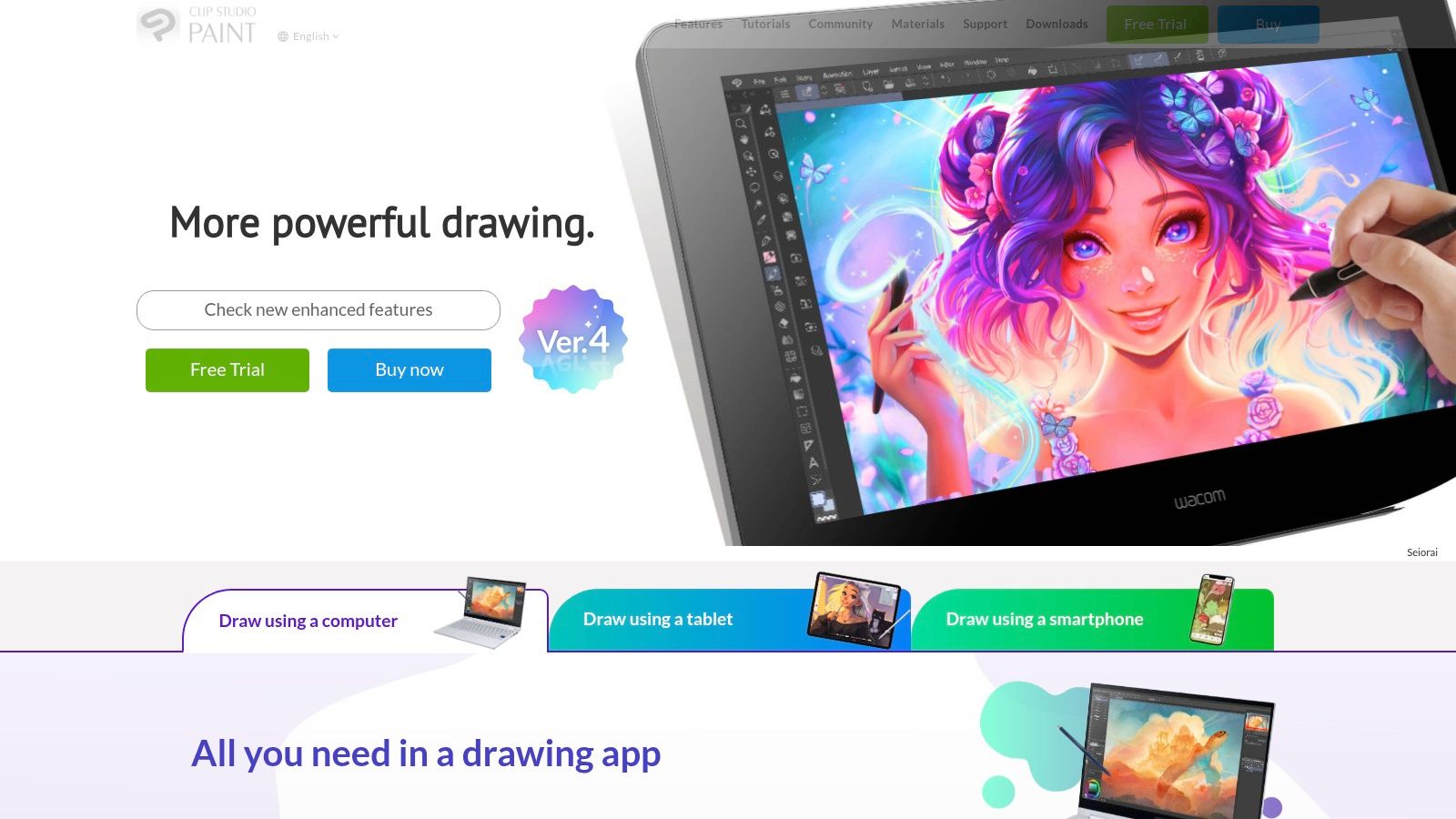
What makes Clip Studio Paint exceptional for aspiring artists is its incredible brush engine, which offers unparalleled customization for creating the perfect line quality. The software's strong support for vector layers allows you to resize and edit your line art without losing quality, a crucial feature for clean, professional work. Furthermore, its massive online asset library provides thousands of brushes, 3D models, and materials, giving beginners a huge head start. For those interested in adding unique visual flair to their work, you can explore tutorials on how to add effects to photos and illustrations.
Key Considerations
The software is available in two main versions: PRO for character art and illustration, and the more expensive EX, which includes advanced features for multi-page comics and unlimited animation frames. While the interface can seem busy at first, its layout is highly customizable to suit your workflow. The lack of advanced photo-editing tools is a minor drawback, as its primary focus remains squarely on drawing and painting.
- Best For: Comic and manga artists, illustrators, and animators looking for specialized tools.
- Pricing: One-time purchase available (around $54 for PRO, $219 for EX). Flexible monthly plans are also offered for specific devices.
- Limitation: The interface can have a learning curve for complete beginners, and it is not a dedicated photo editor.
Website: https://www.clipstudio.net/en/
6. Krita
For those who want powerful features without a price tag, Krita stands out as a premier open-source digital painting program. Developed by a community of artists, it's designed specifically for illustration, comics, and concept art. Its user interface is clean and surprisingly intuitive, making it some of the best digital art software for beginners who are on a budget but unwilling to compromise on professional-grade tools.
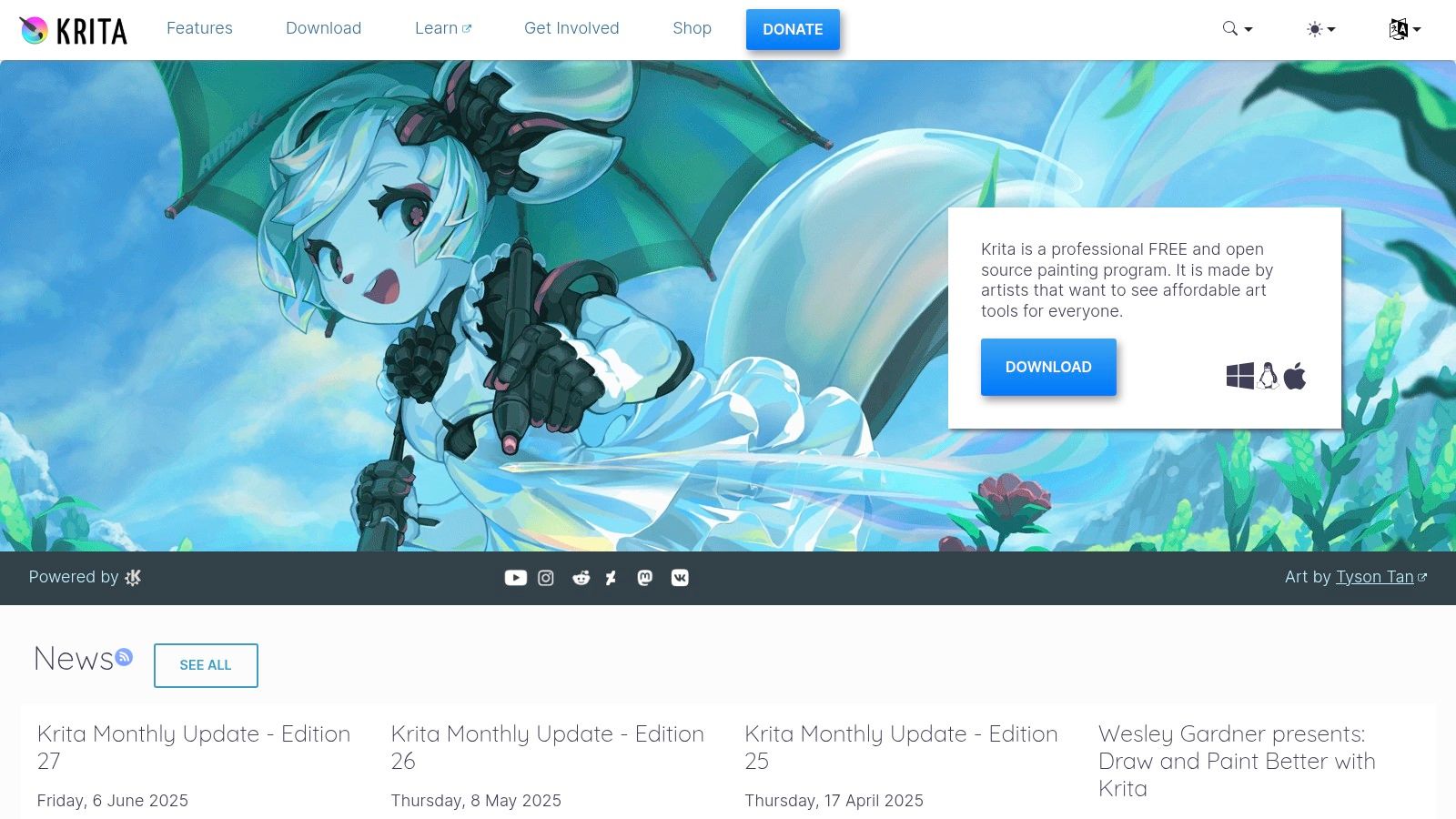
What makes Krita exceptional is its phenomenal brush engine. It comes pre-loaded with over 100 professional-quality brushes, and its customization options are incredibly deep, allowing artists to create and save unique brush presets. Krita also offers useful tools often found in paid software, like a brush stabilizer for smooth lines, built-in vector tools for clean shapes, and a wrap-around mode for creating seamless patterns and textures. The active community is a huge asset, providing free tutorials, brush packs, and support.
Key Considerations
Being a community-driven project, Krita may experience occasional stability issues or have a less frequent update schedule compared to its commercial counterparts. However, its development is constant, and user feedback directly influences new features. The interface is highly customizable, which is a bonus for experienced users but might take some time for a complete beginner to set up perfectly for their workflow.
- Best For: Hobbyists, students, and aspiring artists looking for a powerful, no-cost alternative to paid software.
- Pricing: Completely free and open-source. Donations are encouraged to support development.
- Limitation: Performance can sometimes lag with very large files or complex brushes on lower-spec hardware, and it lacks the ecosystem integration of suites like Adobe.
Website: https://krita.org/en/
7. Corel Painter
For artists transitioning from a traditional canvas to a digital one, Corel Painter offers a uniquely familiar and powerful experience. It stands out by meticulously emulating real-world media, from thick, impasto-style oils to delicate watercolor washes that bleed and blend on a digital paper texture. This focus on realistic painting simulation makes it some of the best digital art software for beginners who want their digital work to retain the soul and texture of physical art.
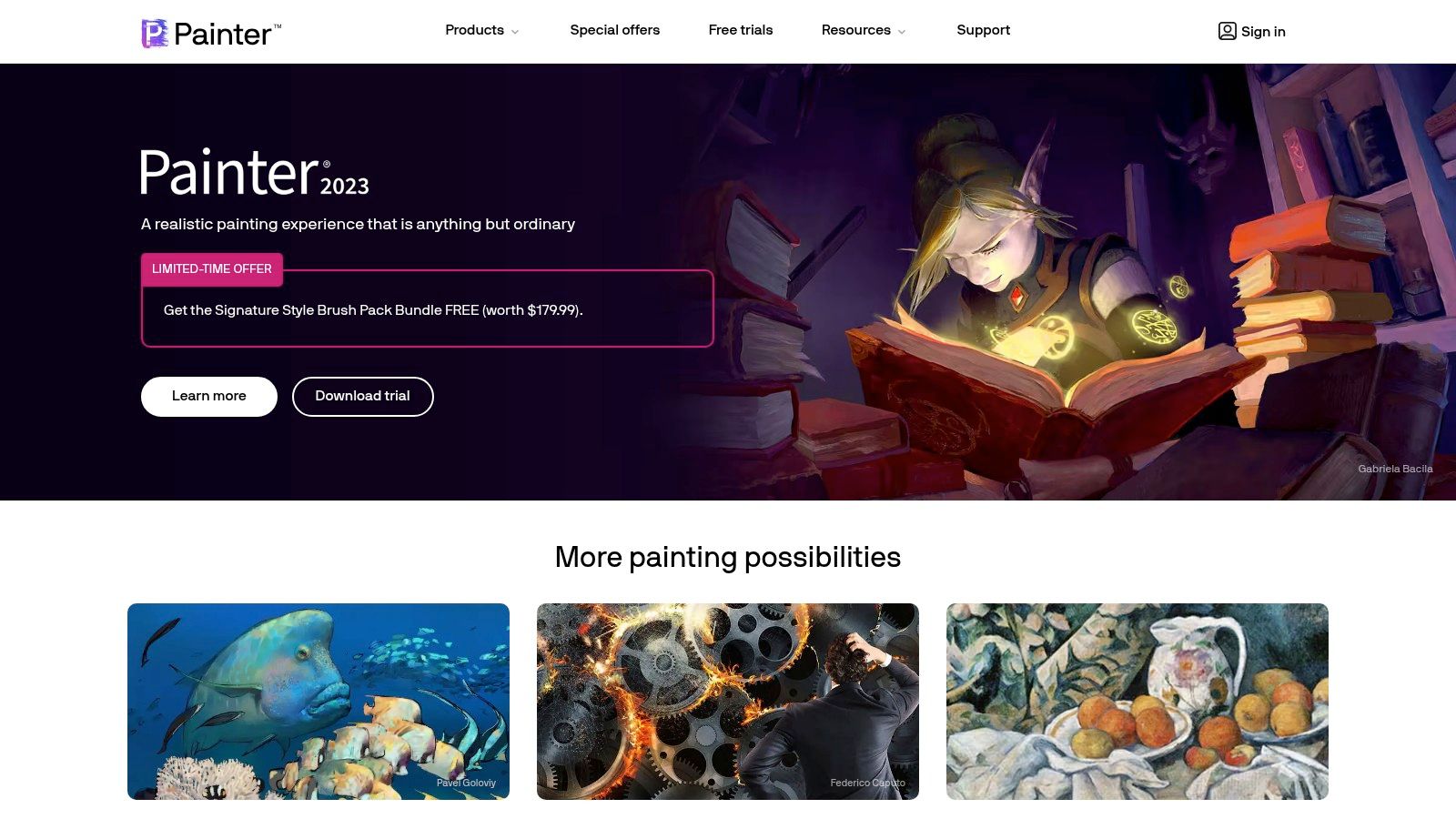
What makes Corel Painter special is its vast library of "Natural-Media" brushes. These aren't just digital stamps; they are complex tools designed to react to stylus pressure, tilt, and rotation just like their real-life counterparts. The software provides deep customization, allowing you to create custom palettes, arrange your workspace, and fine-tune brush physics to perfectly match your artistic style, offering an unparalleled level of control over your digital medium.
Key Considerations
Corel Painter is professional-grade software and comes with a corresponding one-time purchase price, though subscriptions are also available. This can be a significant initial investment compared to free or lower-cost subscription apps. While powerful, its interface and extensive options present a steeper learning curve for complete beginners who have no background in either traditional or digital art. However, for those with painting experience, the interface can feel more intuitive than general-purpose image editors.
- Best For: Traditional artists moving to digital, illustrators, and fine artists seeking realistic media simulation.
- Pricing: A one-time purchase of around $429, or an annual subscription starting at $229/year. A free trial is available.
- Limitation: The high upfront cost and complex, specialized toolset may be overwhelming for casual users or those new to art entirely.
Website: https://www.painterartist.com/en/
8. Autodesk SketchBook
Autodesk SketchBook has carved out a niche as a beloved tool that prioritizes the pure act of drawing. Originally a premium application, it’s now largely free, offering a remarkably powerful feature set without a price tag. Its core strength lies in its minimalist, unobtrusive interface that puts your canvas front and center, making it some of the best digital art software for beginners who want to focus on sketching and ideation without getting bogged down by complex menus.
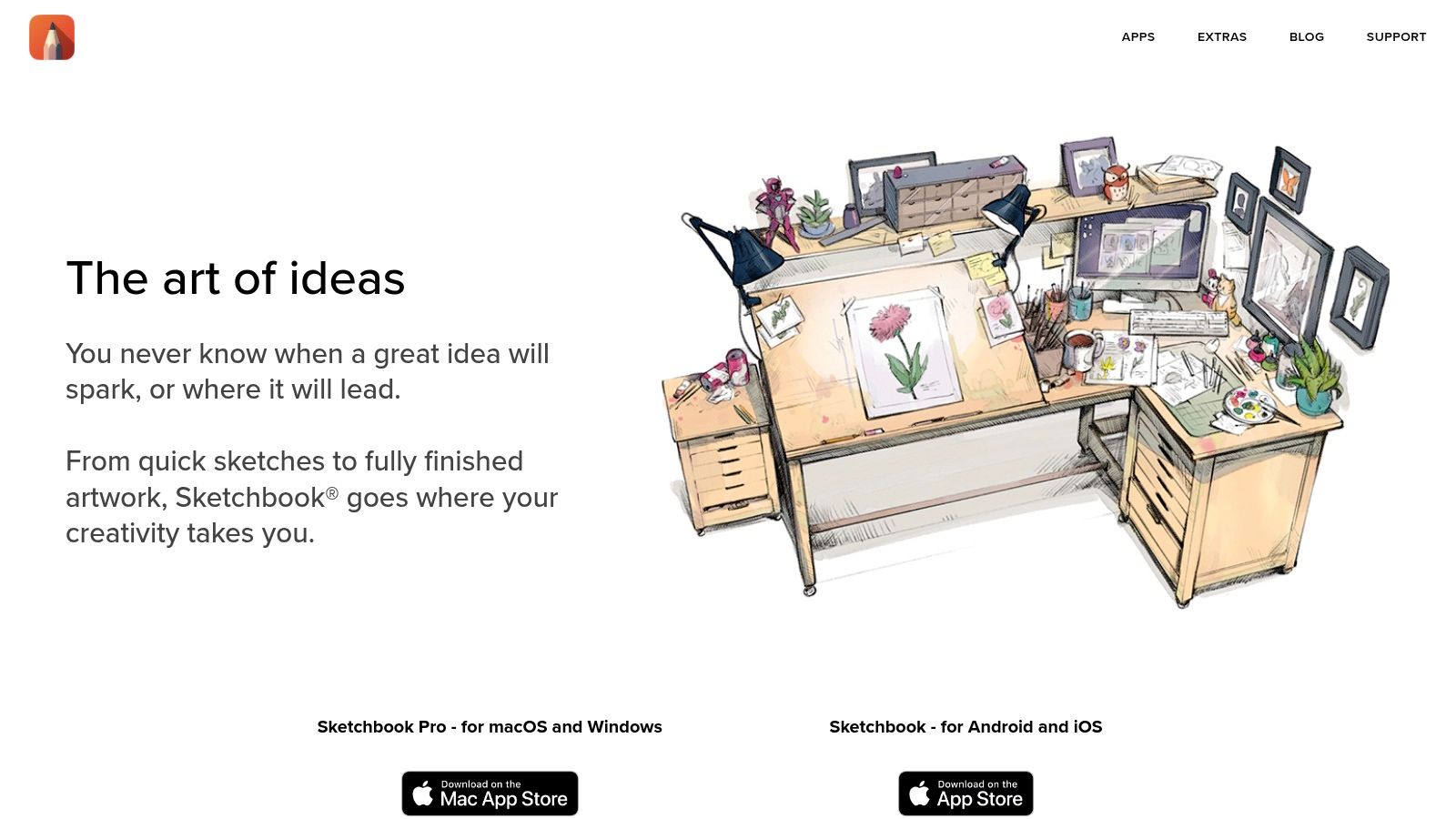
What makes SketchBook stand out is its superior drawing engine and incredible brush library. The tools feel natural and responsive, closely mimicking traditional media like pencils, markers, and airbrushes. Features like predictive stroke help beginners draw smooth, confident lines, while perspective guides simplify the process of creating complex scenes. Its availability across desktop and mobile platforms also allows for a fluid workflow, letting you start a sketch on a tablet and finish it on a PC.
Key Considerations
While the core desktop and mobile apps are free, there is a paid version that unlocks more advanced features, but the free offering is more than sufficient for most beginners. The software's focus on drawing and painting means it lacks advanced photo manipulation or vector tools found in more comprehensive suites like Photoshop or Clip Studio Paint. Updates have also become less frequent since its shift to a mostly-free model.
- Best For: Beginners and hobbyists who want a focused, high-quality digital sketching experience without a financial commitment.
- Pricing: The legacy versions for desktop and mobile are now free. A new version with more features is available for a one-time purchase on some platforms.
- Limitation: It is not a complete creative suite; it lacks advanced features for text, vector graphics, and complex post-processing.
Website: https://www.sketchbook.com/
9. ArtRage
For beginners who dream of traditional painting but want the convenience of digital, ArtRage is a delightful and highly focused program. It excels at simulating real-world art materials, allowing you to smear thick oil paints, blend delicate watercolors that soak into the canvas texture, and sketch with realistic pencils. This focus on natural media makes it some of the best digital art software for beginners who find complex, multi-purpose programs overwhelming and just want to paint.
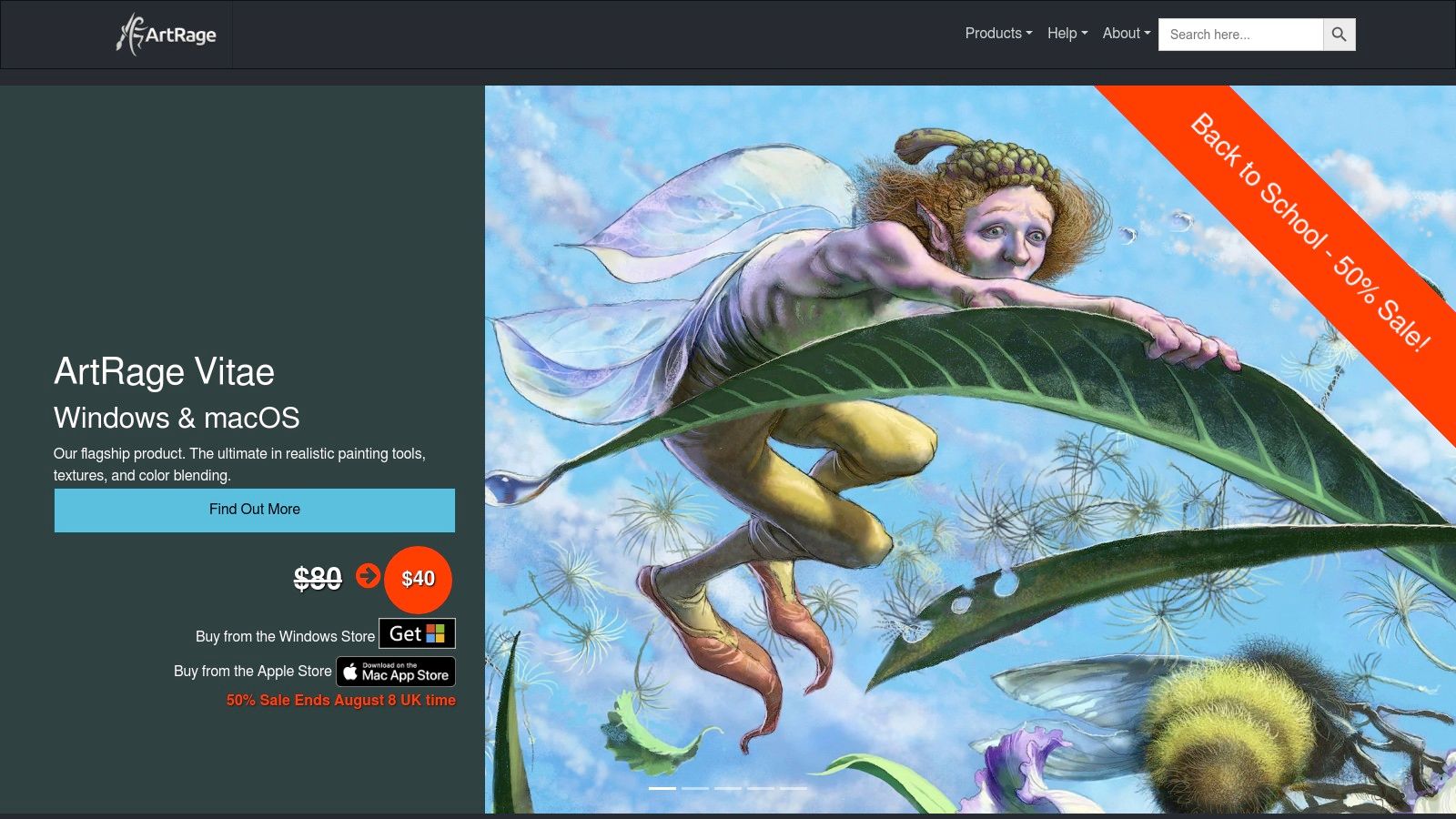
The user interface is notably clean and intuitive, avoiding the intimidating menus of more comprehensive software. Tools are presented in a way that feels instantly familiar to anyone who has used a physical art set. You can even pin reference images directly onto your canvas, just like you would in a real studio, making it easier to study and replicate your subjects without splitting your screen.
Key Considerations
ArtRage is not designed to be an all-in-one graphic design or photo-editing suite; its strength is its singular focus on painting. While it has layers and essential digital tools, it lacks the advanced features like complex text tools or vector capabilities found in competitors. The software is available for a one-time purchase, making it an incredibly affordable, non-subscription alternative for hobbyists.
- Best For: Artists transitioning from traditional media and beginners who want a simple, realistic painting experience.
- Pricing: A one-time purchase. ArtRage Vitae (desktop) is around $80, with more affordable versions available for mobile devices (iOS/Android).
- Limitation: The focus on natural media simulation means it lacks advanced digital manipulation and graphic design tools. Performance with very thick paint and large canvases can be demanding on older hardware.
Website: https://www.artrage.com/
10. Rebelle
For artists who cherish the tactile, unpredictable nature of traditional painting, Rebelle offers a truly unique digital experience. It moves beyond standard digital brushes to simulate the physical behavior of real-world media. This software masterfully replicates how watercolor pigments flow, blend, and diffuse into wet paper, and how thick acrylic or oil paints build texture on a canvas. This focus on authentic simulation makes it some of the best digital art software for beginners who come from a traditional art background and want to transition their skills to a digital format.
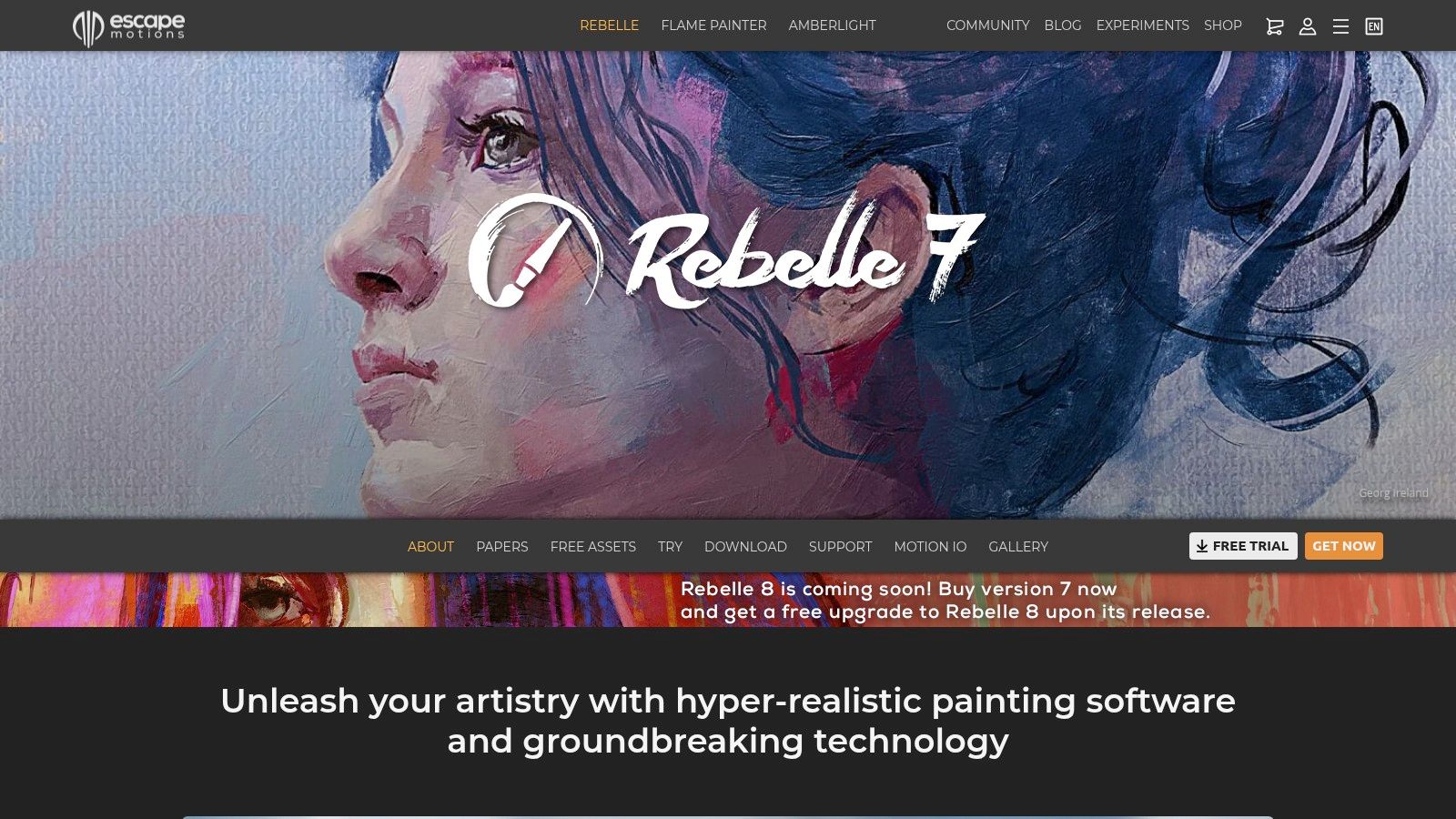
The magic of Rebelle lies in its groundbreaking technology. Its "DropEngine" simulates water drips, while the "NanoPixel" system ensures that when you zoom in, the canvas texture and pigment details remain incredibly sharp and realistic. This allows for an organic and intuitive creative process that feels less like manipulating pixels and more like actual painting, where you can even digitally tilt your canvas to influence the paint flow.
Key Considerations
The hyper-realistic simulations are resource-intensive, so a computer with a capable processor and sufficient RAM is recommended for a smooth experience. While it excels at painting, Rebelle lacks the extensive photo editing and graphic design tools found in programs like Photoshop. It is sold as a one-time purchase, making it an attractive alternative to subscription models.
- Best For: Traditional artists, watercolorists, and anyone who wants a hyper-realistic painting experience.
- Pricing: One-time purchase. Rebelle 7 starts at $89.99, with a more feature-rich Pro version available.
- Limitation: The focus on realistic painting means it's not an all-in-one solution for graphic design or text manipulation.
Website: https://www.escapemotions.com/products/rebelle/
11. GIMP
GIMP (GNU Image Manipulation Program) is often hailed as the best free alternative to Adobe Photoshop, making it a powerful contender for the best digital art software for beginners on a budget. It is a completely open-source raster graphics editor that provides a robust toolkit for digital painting, photo manipulation, and graphic design. Its open-source nature means it is constantly being improved by a global community of developers.
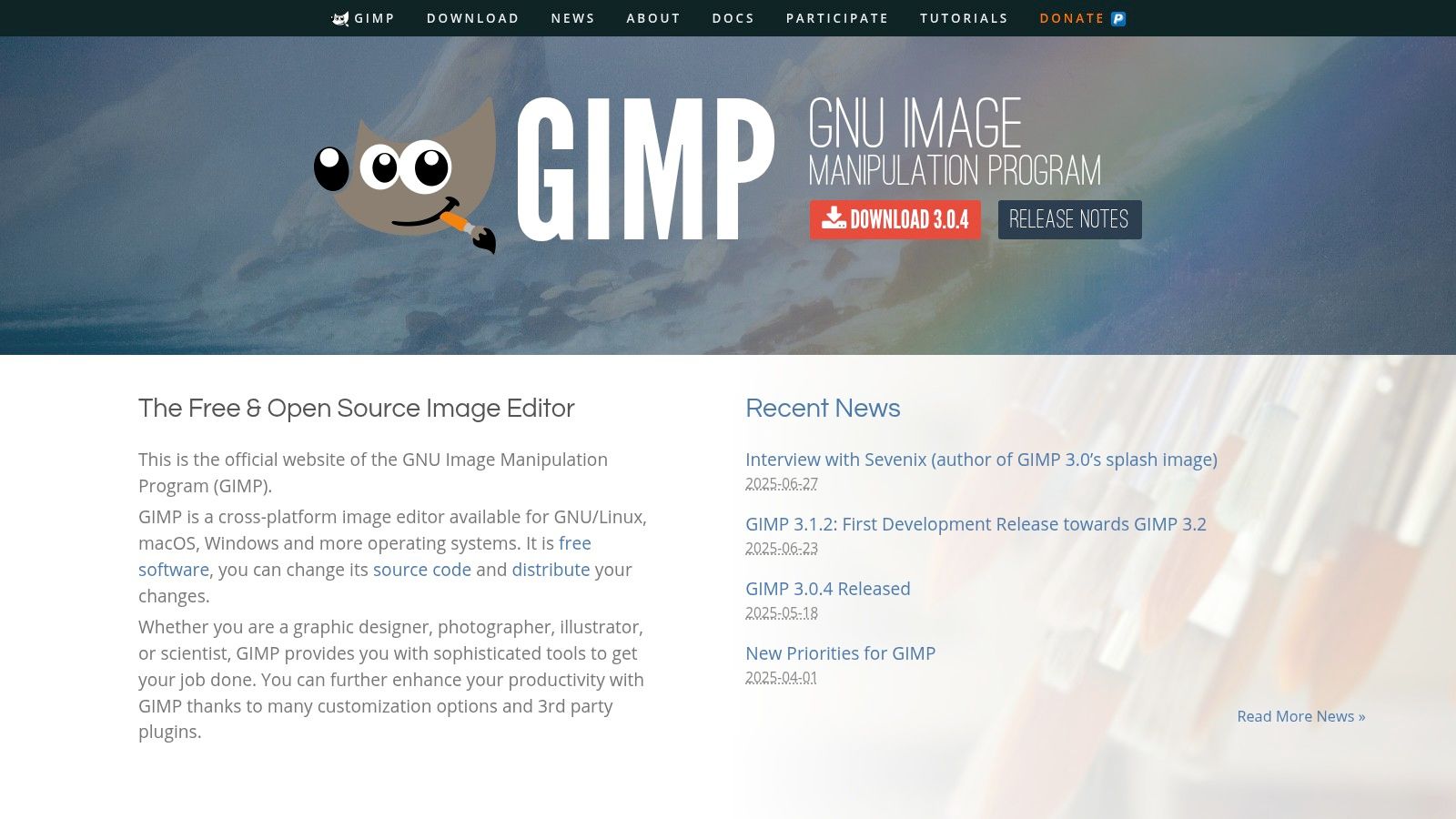
What makes GIMP stand out is its sheer power and customizability offered at no cost. Beginners have access to a comprehensive set of painting tools, including brushes, pencils, and an airbrush, along with layers and channels. The interface is highly customizable, allowing users to arrange docks and windows to create a workspace that suits their personal workflow, a feature that can help ease the learning process over time.
Key Considerations
GIMP's biggest advantage is that it is entirely free, with no subscriptions or hidden fees. However, its user interface can feel less intuitive and more dated compared to modern paid software, presenting a steeper learning curve for some. The strong community support is a major plus, offering countless free tutorials, plugins, and brushes that can significantly expand the program's core capabilities for aspiring artists.
- Best For: Hobbyists, students, and anyone seeking a powerful, no-cost digital art tool.
- Pricing: Completely free and open-source.
- Limitation: The interface is not as polished as its paid competitors, which may frustrate absolute beginners.
Website: https://www.gimp.org/
12. Inkscape
Inkscape is a powerful and free open-source alternative for vector graphics, making it an exceptional starting point for anyone interested in logos, illustrations, or technical diagrams. Unlike raster-based programs like Photoshop or Krita that use pixels, Inkscape uses mathematical equations to create clean, scalable art. This makes it some of the best digital art software for beginners who want to master the art of vector design without any financial commitment.
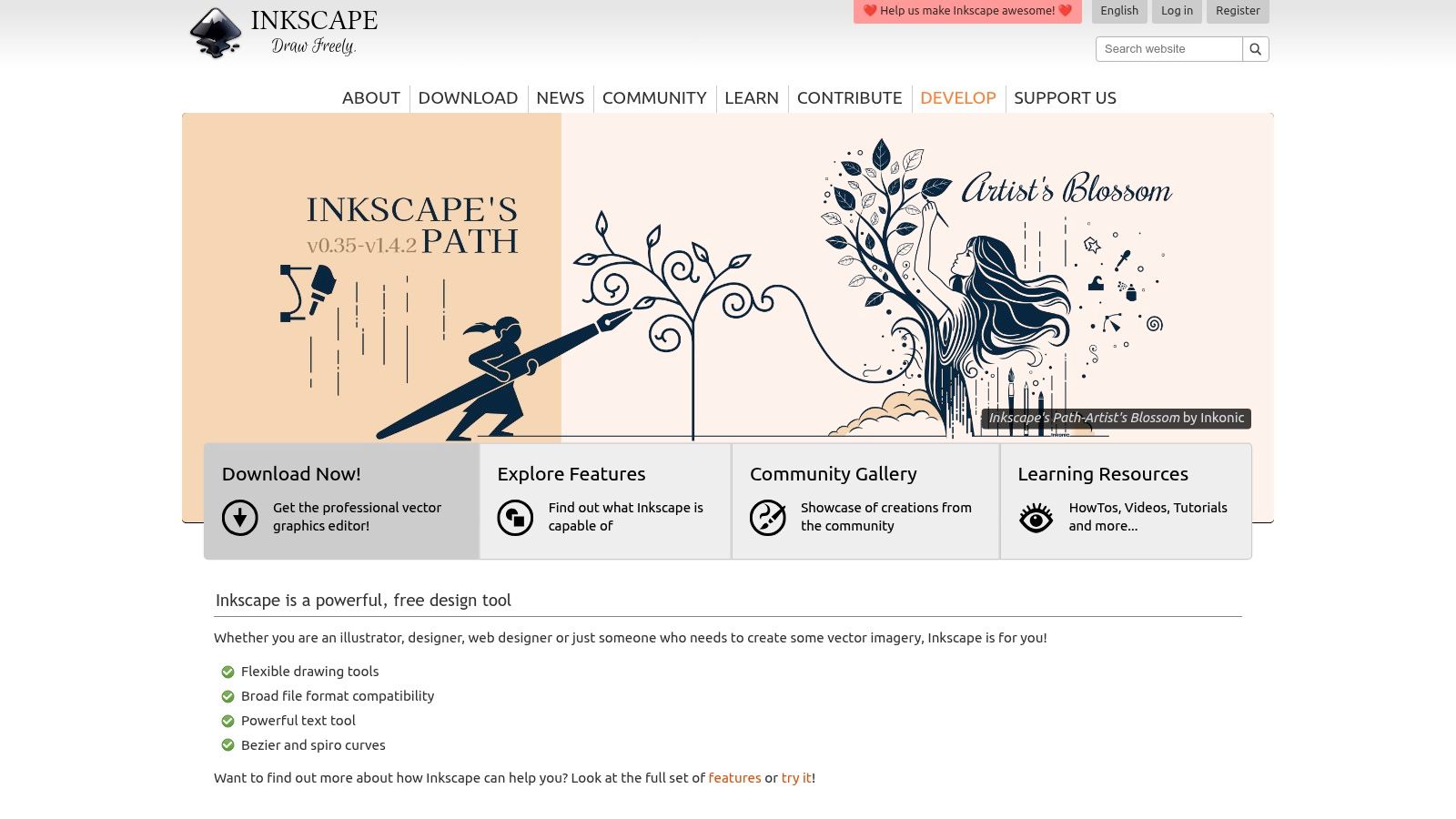
What makes Inkscape a standout choice is its professional-grade feature set, including comprehensive drawing tools like bezier and spiro curves, advanced object manipulation, and robust text support. The software fully supports the standard SVG (Scalable Vector Graphics) file format, ensuring compatibility across different platforms and web browsers. Its highly customizable interface and active community, which provides countless tutorials and extensions, create a supportive environment for learning.
Key Considerations
While incredibly capable, Inkscape has a steeper learning curve compared to some paid alternatives, especially for those unfamiliar with vector concepts. The user experience can feel less polished, and the software may experience performance issues when handling extremely complex designs with many nodes or layers. However, its zero-cost barrier to entry makes these trade-offs highly acceptable for many aspiring designers.
- Best For: Beginners on a budget, aspiring logo designers, and anyone creating art for web or print that needs to be scaled.
- Pricing: Completely free and open-source.
- Limitation: The interface can be intimidating for absolute beginners, and it may slow down with highly complex projects.
Website: https://inkscape.org/
Top 12 Beginner Digital Art Software Comparison
| Product | Core Features/Characteristics | User Experience/Quality ★ | Value Proposition 💰 | Target Audience 👥 | Unique Selling Points ✨ |
|---|---|---|---|---|---|
| 🏆 ai-media-studio | 50+ AI art & video styles, text-to-image/video, editing | ★★★★☆ easy, no design skills | Free tier + tiered plans, commercial rights | Creators, marketers, businesses, pros | AI-powered, fast, collaboration, privacy-focused |
| Adobe Creative Cloud | Industry-standard creative suite, seamless Adobe integration | ★★★★★ professional-grade | Subscription-based, costly over time | Professionals, agencies | Extensive tools & resources |
| Procreate | Intuitive iPad app, Apple Pencil support | ★★★★☆ natural drawing exp. | One-time purchase, no subscription | Beginners, digital artists on iPad | iOS exclusive, brush customization |
| Affinity Designer | Vector & raster design, multi-platform | ★★★★☆ professional tools | One-time purchase, no fees | Beginners & professionals | Cost-effective Adobe alternative |
| Clip Studio Paint | Drawing, animation, assets library, vector support | ★★★★☆ versatile & powerful | One-time or subscription options | Comic/manga artists, illustrators | Cross-platform, 3D model support |
| Krita | Free, open-source, brushes & vectors | ★★★★☆ strong community support | Completely free | Beginners, pros, hobbyists | Free & customizable |
| Corel Painter | Realistic painting tools, textures | ★★★★☆ highly customizable | High upfront cost | Professional artists | Natural media emulation |
| Autodesk SketchBook | Intuitive, wide drawing tools, cross-platform | ★★★★☆ minimalist & robust | Free version available | Beginners & professionals | Simple UI, multi-device |
| ArtRage | Realistic traditional tools (oils, watercolors) | ★★★☆☆ user-friendly | Affordable, multi-platform | Beginners & professionals | Realistic traditional painting focus |
| Rebelle | Real-world paint simulation (flow, drying) | ★★★★☆ authentic experience | Paid, regular updates | Artists seeking natural media feel | Unique pigment & drying physics |
| GIMP | Open-source raster editor, customizable | ★★★☆☆ powerful but complex | Completely free | Beginners & pros, budget-conscious | Free, extensible with plugins |
| Inkscape | Open-source vector editor, bezier/spiro curves | ★★★☆☆ powerful but steep learning | Completely free | Designers, illustrators | Free vector alternative |
Choosing Your Creative Canvas and Making Your First Mark
The journey into digital art can feel like staring at a vast, blank canvas. It's exciting, but also a little intimidating. After navigating through the diverse landscape of digital art tools, from the industry-dominating Adobe Creative Cloud to the community-driven power of Krita, one thing is clear: the best digital art software for beginners is not a singular, definitive answer. Instead, it is a personal choice, deeply intertwined with your individual goals, artistic style, and practical constraints.
This guide was designed to act as your compass, helping you navigate the options and find the program that feels less like a complex piece of technology and more like a natural extension of your creative mind. The perfect software for a comic book artist using a drawing tablet will be different from that for a social media manager creating quick graphics on an iPad. The key is to match the tool to the task, and more importantly, to the artist.
Key Takeaways: Matching the Software to Your Ambition
Let's distill our extensive exploration into a few core decision-making frameworks. Your choice will likely pivot on three fundamental factors: your budget, your hardware, and your primary artistic goal.
-
For the Budget-Conscious Beginner: Don't let a price tag be a barrier to entry. Powerful, open-source programs like Krita and GIMP offer a professional-grade experience completely free of charge. Autodesk SketchBook also provides a fantastic, streamlined drawing experience on its free tier, making it an excellent starting point.
-
For the iPad Enthusiast: If your creative hub is an iPad, Procreate is the undisputed champion. Its intuitive, touch-centric interface, combined with a robust feature set and an affordable one-time price, makes it an almost non-negotiable starting point for Apple Pencil users.
-
For the Aspiring Professional: If your long-term goal is a career in graphic design, illustration, or digital marketing, familiarizing yourself with the Adobe Creative Cloud suite is a strategic investment. Photoshop and Illustrator are the industry-standard languages spoken in creative agencies and marketing teams worldwide.
-
For the Traditional Artist Going Digital: If you want to replicate the feel of real-world paints and canvases, look no further than Corel Painter, Rebelle, or ArtRage. These programs excel at simulating natural media, from thick oil paints to delicate watercolor washes, providing a comfortable transition into the digital realm.
Your Actionable Next Steps: From Selection to Creation
Knowledge is only potential power; action is what transforms it. Staring at a list of features won't make you an artist. The most critical step is to move from analysis to action.
First, leverage free trials. Nearly every paid program we’ve discussed, from Clip Studio Paint to Affinity Designer, offers a trial period. Install two or three that sound promising and dedicate a few hours to each. Don't try to master them; just get a feel for the user interface. Can you find the brush tool easily? Does the layout make sense to you? This hands-on experience is more valuable than any review.
Second, focus on one tool initially. It’s tempting to jump between different programs, a phenomenon known as "shiny object syndrome." Resist this urge. Pick one application and commit to learning its fundamentals. Watch beginner tutorials, learn the basic keyboard shortcuts, and complete a few simple projects. Mastery comes from depth, not breadth.
Finally, remember that the software is just a tool. A master carpenter can build a beautiful chair with a simple saw, while a novice with the most advanced workshop might struggle. Your creativity, practice, and dedication are the true drivers of your success. The best digital art software for beginners is simply the one that gets out of your way and lets you create. It's the one that inspires you to open it day after day, to experiment, to make mistakes, and ultimately, to make your mark. Your digital canvas is waiting.
Ready to skip the steep learning curve and start creating stunning visuals right now? While mastering traditional software takes time, ai-media-studio leverages the power of artificial intelligence to help you generate professional-quality art and marketing assets in seconds. Explore the future of accessible digital creation and bring your ideas to life instantly at ai-media-studio.